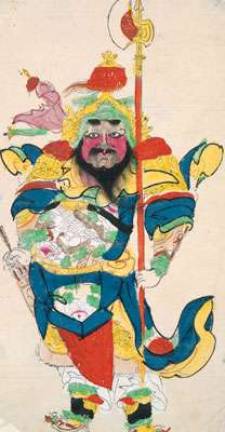Chinese Riches Shortchanged at The Met

The sees itself as a teaching museum, which may be why its curators are trying to cram the entire history of Chinese printmaking into one exhibit: The Printed Image in China: 8th-21st Centuries. Ninth-century Buddhas, 16th-century peonies and 20th-century peasants are all lined up in the back rooms of The Met's Asian wing for your edification. The trouble is that printing is a repetitive medium; a show of this many prints can be a hard slog, even with some beautiful pieces to liven it up. The Chinese invented woodblock printing. And in China, printing very quickly took on religious implications-Buddhism teaches that reproducing sacred texts is a way to receive blessings, so printing became a way to receive blessings while spreading the state religion. The exhibit starts with a room of seventh-, eighth- and ninth-century prints of the Buddha with short texts. There are a few standouts, like the luxuriously painted "Banner with Bodhisattva." But after a while, most of the prints start to take on the sameness of dollar bills-they're spiritual currency. The show moves on to the Ming period (1368-1644), where prints of leaves and flowers are executed with military precision. The period saw a big growth in literacy and wealth; at the same time, color printing took off. The exhibit includes many examples from the Ten Bamboo Shoots Collection of Calligraphy and Painting, a manual for artists full of lichen-covered stones and vines. Color printing flourished into the Qing dynasty (1644-1912), whose Manchu rulers gave away prints to their guests to show off their power. The Qing period verges on the garish; loud pinks and greens, overflowing fruit plates and flower baskets all scream money. The warmest pieces in this show are the so-called popular prints, which ordinary people bought to hang in their homes. Most are "door guardians" from the late 19th century, round-cheeked generals and kitchen gods with open, cartoonish faces. There are a few moving, expressionistic woodcuts from the revolutionary period, too. And the show does include some exciting works from the 1980s and beyond, notably Chen Haiyan's "Dream," an evocative swirl of animals on a black cloud, and Wu Jide's "Fleeting Years." But these pieces beg the question: why isn't The Met giving these artists an exhibit of their own? We would never see contemporary French or Italian artists wedged into a show of this historic scope. Contemporary Chinese artists deserve the same respect we give their Western counterparts. The Printed Image in China: 8th-21st Centuries Through July 29, The Metropolitan Museum of Art, 1000 5th Ave., 212-923-3700,[www.metmuseum.org](http://www.metmuseum.org/).